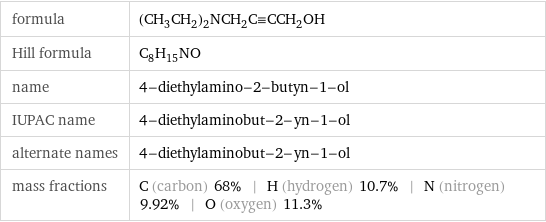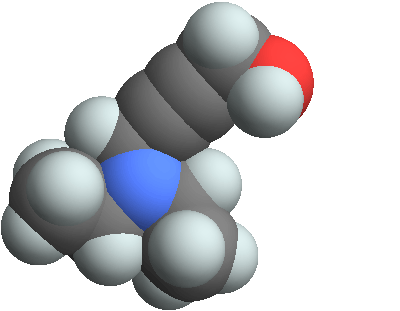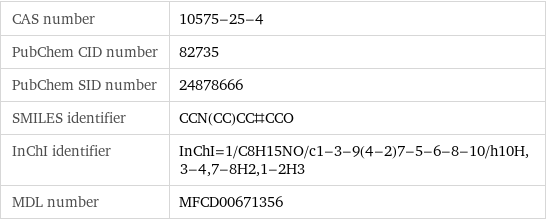Input interpretation

4-diethylamino-2-butyn-1-ol
Chemical names and formulas

formula | (CH_3CH_2)_2NCH_2C congruent CCH_2OH Hill formula | C_8H_15NO name | 4-diethylamino-2-butyn-1-ol IUPAC name | 4-diethylaminobut-2-yn-1-ol alternate names | 4-diethylaminobut-2-yn-1-ol mass fractions | C (carbon) 68% | H (hydrogen) 10.7% | N (nitrogen) 9.92% | O (oxygen) 11.3%
Lewis structure

Draw the Lewis structure of 4-diethylamino-2-butyn-1-ol. Start by drawing the overall structure of the molecule, ignoring potential double and triple bonds: Count the total valence electrons of the carbon (n_C, val = 4), hydrogen (n_H, val = 1), nitrogen (n_N, val = 5), and oxygen (n_O, val = 6) atoms: 8 n_C, val + 15 n_H, val + n_N, val + n_O, val = 58 Calculate the number of electrons needed to completely fill the valence shells for carbon (n_C, full = 8), hydrogen (n_H, full = 2), nitrogen (n_N, full = 8), and oxygen (n_O, full = 8): 8 n_C, full + 15 n_H, full + n_N, full + n_O, full = 110 Subtracting these two numbers shows that 110 - 58 = 52 bonding electrons are needed. Each bond has two electrons, so in addition to the 24 bonds already present in the diagram add 2 bonds. To minimize formal charge carbon wants 4 bonds. Identify the atoms that want additional bonds and the number of electrons remaining on each atom: Fill in the 2 bonds by pairing electrons between adjacent highlighted atoms: Answer: | |
3D structure

3D structure
Basic properties

molar mass | 141.21 g/mol phase | liquid (at STP) boiling point | 231.5 °C density | 0.952 g/cm^3
Units

Liquid properties (at STP)

density | 0.952 g/cm^3 refractive index | 1.479
Units

Chemical identifiers

CAS number | 10575-25-4 PubChem CID number | 82735 PubChem SID number | 24878666 SMILES identifier | CCN(CC)CC#CCO InChI identifier | InChI=1/C8H15NO/c1-3-9(4-2)7-5-6-8-10/h10H, 3-4, 7-8H2, 1-2H3 MDL number | MFCD00671356
Safety properties

flash point | 104.4 °C